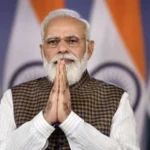Telugu, Muslim, and Odia Community Leaders Spread Message of Communal Harmony; Mahaprasad Distributed
Surat. On the auspicious occasion of Diwali and the New Year, a grand ‘Snehamilan’ (friendship program) and welcome ceremony was organized at the Jagannath Math Puri Balaji Temple located in Govind Nagar. The main objective of this program was to promote happiness, peace, and communal harmony among different communities.
Wishing for prosperity and harmony, the welcome program featured the distribution of Mahaprasad and offerings to the deity. During this time, the presence of prominent leaders from Surat’s Telugu community, Muslim community, and Odia community was noted.
Addressing the Snehamilan, a leader from the Telugu community extended Diwali greetings to everyone and expressed wishes for happiness, peace, prosperity, and communal harmony for all members of the community.
This welcome ceremony became a beautiful example of inter-community unity. This friendship program was attended by various community members who contributed to making the event successful.
The ‘Snehamilan’ program organized on the occasion of Diwali and New Year conveys the message of strengthening the spirit of friendship and brotherhood in society through religious festivals.
Jagannath Math Puri Balaji Temple
The Jagannath Math Puri Balaji Temple is a modern Hindu temple complex in Puri, Odisha, dedicated to Lord Venkateswara (Balaji). It was established by the Sri Jagannath Math, a religious institution, to provide a prominent place of worship for the deity in the sacred city of Puri. While a new structure, its location connects it to the ancient and profound spiritual heritage of Puri, a major pilgrimage site.
Diwali
Diwali, also known as the Festival of Lights, is a major religious and cultural celebration originating in the Indian subcontinent, primarily observed by Hindus, Sikhs, and Jains. Its history is rooted in various ancient legends, most commonly the story of Lord Rama’s return to his kingdom after 14 years of exile. Today, it symbolizes the spiritual victory of light over darkness and good over evil, marked by the lighting of oil lamps, fireworks, family gatherings, and prayers.
New Year
“New Year” is a global cultural event marking the beginning of a new calendar year, observed on various dates by different cultures and religions, most famously on January 1st in the Gregorian calendar. Its history is ancient, with celebrations like the Roman festival of Janus and the Babylonian Akitu, often symbolizing renewal, reflection, and hope. Modern traditions include fireworks, resolutions, and social gatherings, uniting people worldwide in a shared moment of transition.
Snehamilan
I am unable to provide a summary for “Snehamilan” as it does not appear to be a widely recognized historical place, cultural site, or prominent landmark. It is possible the name refers to a local business, a community center, a fictional location, or may be misspelled. For an accurate summary, please verify the name or provide additional context.
Mahaprasad
Mahaprasad refers to the sacred food offered to Lord Jagannath at the Puri Temple in Odisha, India. Its history is deeply intertwined with the temple’s rituals, dating back centuries, and it is considered unique as it is prepared in a traditional manner without any caste distinctions. The Mahaprasad is believed to be blessed by the deity and is distributed to millions of devotees as a form of divine grace.
Telugu community
The Telugu community is a Dravidian ethnolinguistic group native to the Indian states of Andhra Pradesh and Telangana, with a rich history dating back over two millennia. Their cultural heritage is defined by the Telugu language, one of India’s classical languages, and celebrated through vibrant festivals, Kuchipudi dance, and Telugu cinema. The community has a significant global diaspora, maintaining strong cultural ties while contributing to societies worldwide.
Muslim community
The global Muslim community, known as the Ummah, is a transnational cultural and spiritual body united by the Islamic faith. Its history began in 7th-century Arabia with the revelations received by the Prophet Muhammad, and it rapidly expanded through trade, scholarship, and empire, creating a diverse civilization spanning continents. Today, it encompasses over a billion people from a vast array of ethnicities, cultures, and traditions, all sharing core religious beliefs and practices.
Odia community
The Odia community is an ethnolinguistic group native to the Indian state of Odisha, with a rich history dating back to ancient Kalinga. Their culture is renowned for its classical Odissi dance, intricate temple architecture like the Jagannath Temple in Puri, and vibrant festivals such as the Rath Yatra. The Odia language, with its own distinct script, is one of India’s classical languages.






